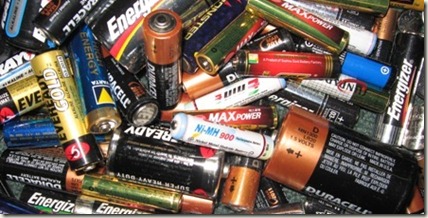Disposing of Dead Batteries? Not so fast...
[It’s been a long while since my last post – it’s good to be back!]
I replaced some alkaline batteries in my son's "activity seat" the other day. As am I allergic to waste, I habitually test the batteries I replace to see if they really are dead. As I've noticed before, in this case only one of the three batteries was completely dead. One of them had a full charge and the other had at least 50% of its useful charge left. As a result, I only needed to replace one battery, although I expect that most consumers would have habitually replaced the whole set. At scale I suspect this represents a lot of good batteries disposed of every day.
I tend not to throw away dead alkalines either. While I've not experimented with alkaline battery chargers, I keep them in a bag and drop them off at local recycling events when I get a chance. Apparently batteries manufactured after 1996 are supposedly safe enough to send to the landfill (aka 'trash'), but to me this seems rather wasteful and a missed opportunity for an enterprising battery manufacturer, as Chris Jordan's images so vividly illustrate (battery image is 2nd from the bottom of the long set of images).
And while I normally use rechargeable batteries for the most frequently and heavily used devices and toys, as you might have guessed, I'm not opposed to using alkaline batteries for devices that don't use much energy and/or go for months or even years between replacements. And for the D cells in the baby seat, I have so few devices that use that type that investing in a special charger hasn't seemed worth it.
Based on the battery strategy I’ve refined over the years, I recommend the following approach to ‘living with batteries’.
1) Buy a battery tester and test batteries before you throw them out. You’ll likely save money very quickly. You get get a cheap one that just tests voltage or a more sophisticated one that actually tests the load and provides more accurate results.
2) Buy a good battery charger. Fast chargers aren’t always kind to your batteries. I use the LaCrosse Technologies charger and have had good results. You can vary the charger voltage depending on how much of a hurry you are in.
3) Invest in rechargeable batteries for frequently used devices (such as digital cameras and favorite toys). In particular, buy rechargeable batteries that don’t go dead if they sit idle for a few weeks. The Sanyo eneloop AA batteries are pre-charged and hold their charge much better than traditional Ni-MH batteries, plus they are environmentally friendly (so they say!).
4) For frequently used devices that need bigger batteries, buy battery adapters that convert AA batteries to fit in devices that need C cell or D cell batteries and use them with your rechargeable batteries.
5) For devices that use batteries very slowly because of low drain or infrequent use, I contend that the most cost effect and environmentally friendly choice is good old fashioned alkalines like the Duracell Procell.
6) Put all of your old batteries in a big “ziplock” bag and take them with you to a local recycling event. At Microsoft, we have onsite battery recycling via a company called Veolia, so I bring mine into the office once in a while and drop them in the designated bin.
Hope that helps!
